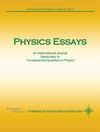Completing Dirac’s work. The Dirac electron is a 2D hologram
IF 0.5
Q4 PHYSICS, MULTIDISCIPLINARY
引用次数: 0
Abstract
The QED-physical (QED-P) theory [J. H. Wilson, Phys. Essays 35, 5 (2022)] is actually the theory Dirac sought in 1962 in his attempt to predict the muon as an “extensible model of the electron.” Recently, Lerche attempted to produce a classical solution to Dirac’s equation for the radial motion of an extensible, basically classical, model of the electron. Both Dirac and Lerche proceeded in the wrong, classical direction in this effort. The QED-P center of charge (CoC) position operator is derived directly from the Dirac equation (DE) CoC velocity operator, cα with no ad hoc assumptions. QED-P was integrated with QED into a single theory, and that integration is proved by the highly accurate estimates of QED that are dependent on the DE velocity operator cα. Both QED and QED-P are based directly on the same Dirac Equation (DE) four current c(α,I) that QED couples with an external electromagnetic field. QED uses covariant perturbation theory to produce highly accurate results, except for the electron selfenergy, which is infinite. The DE velocity operator, cα, is the spatial part of the free electron four current, and has highly unusual properties compared to classical velocity vectors. QED could not produce highly accurate answers without the 4 × 4 complex matrix cα as the electron CoC “velocity” operator. QED-P simply integrates the same Dirac equation four current used so successfully in QED, and produces the discrete internal spatial and time coordinate operators (ISaTCOs) to give the electron field’s internal structure a very specific, but highly, nonclassical geometric description, with no ad hoc assumptions. QED and QED-P are complementary theories, and both are proven to be true by the accurate results of QED. The physical interpretation of QED-P is discussed in this paper as a two-dimensional, rapidly vibrating “point” charge, that is always located on a 2D CoC sphere in the electron rest frame, oscillating rapidly through eight eigenvalues with an ISaTCO period of ∼10−22 s. The fact that the CoC’s eight ISaTCO spatial eigenvectors are always are located on a 2D shell encompassing the electron’s 3D “space” inside the CoC’s 2D shell is a direct consequence of the DE, and nothing else. In this paper, it is shown that the “discrete” ISaTCOs produce a one dimensional, discrete quantum harmonic oscillator with its ISaTCOs always located on a 2D CoC shell. The CoC shell is an “2D hologram” emerging from a 3D volume inside the 2D CoC shell with a vibrational electronic clock” producing an internal phase that is propagated throughout space/time. The QED-P point electron charge rotates 720° to complete one internal electron discrete period. The electron’s spin and magnetic moment [J. H. Wilson, Phys. Essays 29, 402 (2016); ibid. 31(1), 59‐67 (2018); ibid. 34, 17 (2021)] are generated by the CoC ISaTCO in QED-P, and there is no need for “intrinsic” properties. The QED-P electron properties described above d are far different than the standard model’s very small point particle with intrinsic properties of spin and magnetic moment.完成狄拉克的工作。狄拉克电子是二维全息图
QED-物理(QED-P)理论[J. H. Wilson, Phys. Essays 35, 5 (2022)]实际上是狄拉克在1962年试图将μ介子预言为 "电子的可扩展模型 "时所寻求的理论。最近,勒切试图为可扩展的、基本上是经典的电子模型的径向运动给出狄拉克方程的经典解。在这一努力中,狄拉克和勒切都沿着错误的经典方向前进。QED-P 的电荷中心(CoC)位置算子是直接从狄拉克方程(DE)的电荷中心速度算子 cα 中推导出来的,没有任何特别的假设。QED-P 与 QED 集成为一个单一理论,QED 的高精度估计值证明了这种集成,而这种估计值取决于 DE 速度算子 cα。QED 和 QED-P 都直接基于相同的狄拉克方程(DE)四电流 c(α,I),QED 将其与外部电磁场耦合。QED 使用协变扰动理论得出高度精确的结果,但电子自能除外,因为电子自能是无限的。DE 速度算子 cα 是自由电子四电流的空间部分,与经典速度矢量相比具有非常不寻常的性质。如果没有 4 × 4 复矩阵 cα 作为电子 CoC "速度 "算子,QED 就无法得出高度精确的答案。QED-P 只需对 QED 中成功使用的狄拉克方程四电流进行积分,并产生离散的内部空间和时间坐标算子(ISaTCOs),即可对电子场的内部结构进行非常具体但高度非经典的几何描述,而无需任何特别假设。QED 和 QED-P 是互补的理论,QED 的精确结果证明了两者的正确性。本文讨论了 QED-P 的物理解释,即一个快速振动的二维 "点 "电荷,始终位于电子静止帧中的二维 CoC 球上,在八个特征值中快速振荡,ISaTCO 周期为 10-22 秒。CoC 的八个 ISaTCO 空间特征向量总是位于 CoC 的二维外壳上,该外壳包含了 CoC 二维外壳内的电子三维 "空间",这是 DE 的直接结果,与其他无关。本文表明,"离散 "的 ISaTCO 产生了一维离散量子谐振子,其 ISaTCO 始终位于二维 CoC 壳上。CoC 外壳是一个 "二维全息图",从二维 CoC 外壳内部的三维体积中出现,其 "振动电子时钟 "产生的内部相位在整个空间/时间内传播。QED-P 点电子电荷旋转 720°,完成一个内部电子离散周期。电子的自旋和磁矩[J. H. Wilson, Phys. Essays 29, 402 (2016);同上,31(1), 59-67 (2018);同上,34, 17 (2021)]由 QED-P 中的 CoC ISaTCO 产生,无需 "内在 "属性。上述 QED-P 电子特性 d 与标准模型中具有自旋和磁矩等内在特性的极小点粒子大不相同。
本文章由计算机程序翻译,如有差异,请以英文原文为准。
求助全文
约1分钟内获得全文
求助全文
来源期刊

Physics Essays
PHYSICS, MULTIDISCIPLINARY-
自引率
83.30%
发文量
50
审稿时长
6-12 weeks
期刊介绍:
Physics Essays has been established as an international journal dedicated to theoretical and experimental aspects of fundamental problems in Physics and, generally, to the advancement of basic knowledge of Physics. The Journal’s mandate is to publish rigorous and methodological examinations of past, current, and advanced concepts, methods and results in physics research. Physics Essays dedicates itself to the publication of stimulating exploratory, and original papers in a variety of physics disciplines, such as spectroscopy, quantum mechanics, particle physics, electromagnetic theory, astrophysics, space physics, mathematical methods in physics, plasma physics, philosophical aspects of physics, chemical physics, and relativity.
 求助内容:
求助内容: 应助结果提醒方式:
应助结果提醒方式:


